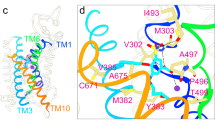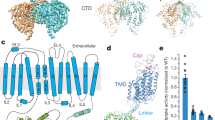Abstract
THE energy-dependent transport of fluid across epithelia has been best explained by the three-compartment conception of Curran and MacIntosh1. This model couples the active ‘pumping’ of solute with the elaboration of an absorbate of specific tonicity by postulation of local osmosis within the epithelium. This reasoning has been extended in the ‘standing-gradient’ hypothesis2, which accounts for isotonic or hypertonic fluid transport by means of epithelial geometry and the specific transport properties of the cell membrane. The hypothesis depends upon a quantitative assessment of several parameters (membrane hydraulic conductivity, solute-pump distribution and dimensions of epithelial intercellular spaces)3. For example, the model best explains isotonic reabsorption by the gallbladder when it is assumed that the solute-input region (the site of energy-dependent Na+ pumping) is confined to the apical portion of the lateral intercellular space2. To test this important assumption, we studied the distribution of Na+ pumps in frog gallbladders with radioautography of 3H-ouabain binding sites5. This is a specific procedure for identifying the site of the enzyme, Na+-K+ ATPase6,7, which in this tissue4, as well as others, is equated with the Na+ pump. We find that Na+ pumps are present only on the basal–lateral surface of the epithelial cells, consistent with their providing solute to the intercellular spaces as the site for local osmosis. However, since the pumps are not limited to the apical portion of the intercellular space, the results do not support the ‘standing-gradient’ view of isotonic fluid transport.
This is a preview of subscription content, access via your institution
Access options
Subscribe to this journal
Receive 51 print issues and online access
$199.00 per year
only $3.90 per issue
Buy this article
- Purchase on Springer Link
- Instant access to full article PDF
Prices may be subject to local taxes which are calculated during checkout
Similar content being viewed by others
References
Curran, P. F. & MacIntosh, J. R. Nature 193, 347–348 (1962).
Diamond, J. M. & Bossert, W. H. J. gen. Physiol. 50, 2061–2083 (1967).
Tormey, J. McD. & Diamond, J. M. J. gen. Physiol. 50, 2031–2060 (1967).
Van Os, C. H. & Slegers, J. F. G. Biochim. biophys. Acta 241, 89–96 (1971).
Stirling, C. E. J. Cell Biol. 53, 704–715 (1972).
Mills, J. W. & Ernst, S. A. Biochim. biophys. Acta 375, 268–273 (1975).
Mills, J. W., Ernst, S. A. & DiBona, D. R. J. Cell Biol. 73, 88–110 (1977).
Baker, P. F. & Willis, J. S. J. Physiol., Lond. 224, 441–462 (1972).
Bindslev, N., Tormey, J. McD. & Wright, E. M. J. Membrane Biol. 19, 357–380 (1974).
Hill, A. E. Proc. R. Soc. B 190, 99–114 (1975).
Segel, L. A. J. theor. Biol. 29, 233–250 (1970).
Sackin, H. & Boulpaep, E. L. J. gen. Physiol. 66, 671–733 (1975).
Author information
Authors and Affiliations
Rights and permissions
About this article
Cite this article
MILLS, J., DIBONA, D. Distribution of Na+ pump sites in the frog gallbladder. Nature 271, 273–275 (1978). https://doi.org/10.1038/271273a0
Received:
Accepted:
Published:
Issue Date:
DOI: https://doi.org/10.1038/271273a0
This article is cited by
-
Cerebrospinal fluid production by the choroid plexus: a century of barrier research revisited
Fluids and Barriers of the CNS (2022)
-
Microscopical methods for the localization of Na+, K+-ATPase
The Histochemical Journal (1981)
-
Osmosis in epithelial membranes
The Journal of Membrane Biology (1981)
Comments
By submitting a comment you agree to abide by our Terms and Community Guidelines. If you find something abusive or that does not comply with our terms or guidelines please flag it as inappropriate.



